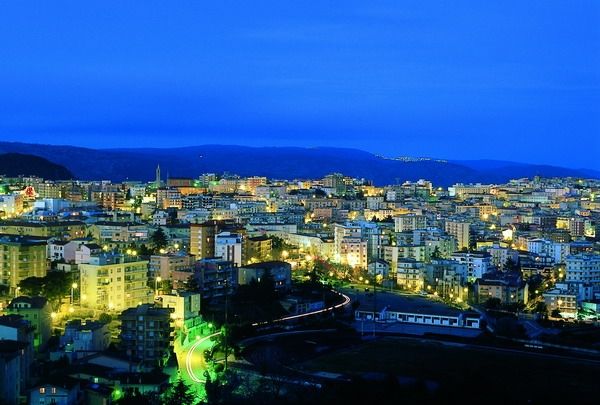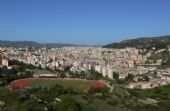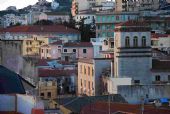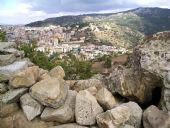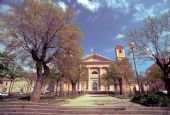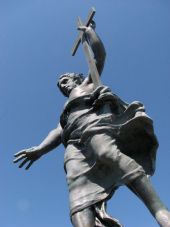
Nuoro
city of culture and traditional hospitality
Capital of a province that has managed to keep alive the traditions and peculiarities of the real Sardinia and oroginale, is both the capital of culture more modern, counting among its citizens prestigious personalities such as the Nobel prize for literature Grazia Deledda (1926 ), the poet Sebastiano Satta (1867-1914), the sculptor Francesco Ciusa (1884-1949), the lawyer-writer Salvatore Satta (1902-1975), essayist and political Attilio Deffenu (1890-19189.
The city is dominated by about a thousand meters of altitude of Mount Ortobene, from where visitors can enjoy an extraordinary view of the whole Barbagia, Supramonte of Orgosolo and Oliena, to the Tyrrhenian Sea that borders the lands of the Baronie, becoming aware of the real physiognomy the Sardinian mountain landscape.
Part Judged of Logudoro, Nuoro was conquered in 1300 by the Aragonese who included it in the Diocese of Alghero.
Its historic center shows two distinct aspects: that of the modern city with the new areas of urban expansion and that of the old quarters of the rural and pastoral culture of San Pietro and Seuna, with narrow streets and low houses drywall.
The old town is gathered around the Sanctuary of the Madonna delle Grazie, built in the fifties in the square, to the nearby Church of Grace, the Cathedral of St. Maria della Neve, the early nineteenth century in Neoclassical style.
Relevant presence museum that represents the interest of the city appreciated by an interesting route.
The Museum of Life and Popular Traditions Sardinian, located on the hill of Sant'Onofrio and opened in 1976, is dedicated to the representation of folklore, crafts and popular culture of Sardinia, including a section dedicated to the traditional costumes, jewelry and goldsmith together with objects of common use, a rich collection of tools of ancient crafts and salt for the exposure of the most famous carnival masks barbaricino (mamuthones, issoccadores Mamoiada, Boes Merdules and Ottana and thurpos Orotelli).
The Museum and archaeological cave (via L. Da Vinci, 5) collects material paleontological, archaeological and natural, with important presence as 4 exceptional menhir statues found in Laconi, some ships votive nuragic, various jewelry, funerary objects of ' Bronze Age and the reconstruction of a Byzantine tomb (VII-VIII sec.).
The birthplace of the writer Grazia Deledda, in the street at number 28, as well as representing an authentic house barbaricino nineteenth century, the childhood home of the great author, houses the Museum Deleddiano with documents and the most significant works of 'artist.
On the northern outskirts of the eastern city is the Church of Solitudine (Sa Solidàe) kind in mid '900, near which is the tomb of Grazia Deledda and the shrine of Our Lady of Valverde of seventeenth-century forms. From here a scenic road that climbs to Monte Ortobene where is the church of NS Montenero (XVII sec.), recently restored, and the Statue of the Redeemer (7 m high. bronze work of Vincenzo Jerace) around which since 1901 takes place in late August one of the most important festivals of the island, the Feast of the Redeemer , with a parade of all the traditional customs of the island.
Nearby, heading towards the extreme south-western outskirts of the city, do not miss the excursion to the Nuraghe Tanca Manna, who form almost one with the imposing rock that is located on site.
A fifteen kilometers to the west, are the domus de janas of Sas Concas, a group of tombs of age prenuragic that boasts a number of special engravings wall of magical-religious.
At about 25 km., In the Municipality of Orune, you can visit the sacred well of Su Tempiesu and, 15 km from Nuoro always, the nuragic Noddule.
From Nuoro it is also recommended a detour to Orani and Sarule with the climb to Monte Gonare, the highest feature of Barbagia admiring the view, with the view of the two seas that surround the island and the church of Our Lady of Gonare medieval.
Orani Nivola obligatory stop at the Museum dedicated to the local artist of international renown Costantino Nivola and located in the old wash house in the country, in order restored.
The city is dominated by about a thousand meters of altitude of Mount Ortobene, from where visitors can enjoy an extraordinary view of the whole Barbagia, Supramonte of Orgosolo and Oliena, to the Tyrrhenian Sea that borders the lands of the Baronie, becoming aware of the real physiognomy the Sardinian mountain landscape.
Part Judged of Logudoro, Nuoro was conquered in 1300 by the Aragonese who included it in the Diocese of Alghero.
Its historic center shows two distinct aspects: that of the modern city with the new areas of urban expansion and that of the old quarters of the rural and pastoral culture of San Pietro and Seuna, with narrow streets and low houses drywall.
The old town is gathered around the Sanctuary of the Madonna delle Grazie, built in the fifties in the square, to the nearby Church of Grace, the Cathedral of St. Maria della Neve, the early nineteenth century in Neoclassical style.
Relevant presence museum that represents the interest of the city appreciated by an interesting route.
The Museum of Life and Popular Traditions Sardinian, located on the hill of Sant'Onofrio and opened in 1976, is dedicated to the representation of folklore, crafts and popular culture of Sardinia, including a section dedicated to the traditional costumes, jewelry and goldsmith together with objects of common use, a rich collection of tools of ancient crafts and salt for the exposure of the most famous carnival masks barbaricino (mamuthones, issoccadores Mamoiada, Boes Merdules and Ottana and thurpos Orotelli).
The Museum and archaeological cave (via L. Da Vinci, 5) collects material paleontological, archaeological and natural, with important presence as 4 exceptional menhir statues found in Laconi, some ships votive nuragic, various jewelry, funerary objects of ' Bronze Age and the reconstruction of a Byzantine tomb (VII-VIII sec.).
The birthplace of the writer Grazia Deledda, in the street at number 28, as well as representing an authentic house barbaricino nineteenth century, the childhood home of the great author, houses the Museum Deleddiano with documents and the most significant works of 'artist.
On the northern outskirts of the eastern city is the Church of Solitudine (Sa Solidàe) kind in mid '900, near which is the tomb of Grazia Deledda and the shrine of Our Lady of Valverde of seventeenth-century forms. From here a scenic road that climbs to Monte Ortobene where is the church of NS Montenero (XVII sec.), recently restored, and the Statue of the Redeemer (7 m high. bronze work of Vincenzo Jerace) around which since 1901 takes place in late August one of the most important festivals of the island, the Feast of the Redeemer , with a parade of all the traditional customs of the island.
Nearby, heading towards the extreme south-western outskirts of the city, do not miss the excursion to the Nuraghe Tanca Manna, who form almost one with the imposing rock that is located on site.
A fifteen kilometers to the west, are the domus de janas of Sas Concas, a group of tombs of age prenuragic that boasts a number of special engravings wall of magical-religious.
At about 25 km., In the Municipality of Orune, you can visit the sacred well of Su Tempiesu and, 15 km from Nuoro always, the nuragic Noddule.
From Nuoro it is also recommended a detour to Orani and Sarule with the climb to Monte Gonare, the highest feature of Barbagia admiring the view, with the view of the two seas that surround the island and the church of Our Lady of Gonare medieval.
Orani Nivola obligatory stop at the Museum dedicated to the local artist of international renown Costantino Nivola and located in the old wash house in the country, in order restored.
-
Search
-
Categories
- APP FAITA Sardegna
- HOLIDAY PACKAGES
- CAMPING VILLAGE Sardinia
- Where to eat
- TRANSPORT Sardinia
- BEACHES in Sardinia
- Tours in Sardinia
- KITCHEN traditional Sardinian
- WINES Sardinia
- SPIRITS of Sardinia
- EVENTS in Sardinia
- CORTES Apertas in Sardinia
- SPORT in Sardinia
- MAP Sardinia
- PHOTOS Sardinia
- VIDEO Sardinia
- Useful Numbers Sardinia
- DOGGIE BEACH in Sardinia
- Contact information
- archivio
-
Topics
- Camping e Village Sardinia
- Tourism in Sardinia
- resorts in Sardinia
- Sardinian beaches routes
- Specialties at the table
- South Coast Cagliari
- Costa Rei itinerari
- Ogliastra itinerari
- Nuoro e provincia itinerari
- Gallura itinerari
- Sassari e provincia itinerari
- Oristano e provincia itinerari
- Autunno in Barbagia 2013
- Aerei per la Sardegna
- Traghetti per la Sardegna
- Storia di Sardegna
- Feste e sagre della Sardegna
- Camping Village e Spiagge dog friendly
- Spiagge accessibili con l'amico cane






